The Arg of Karim Khan in Shiraz | History and Architecture
Shiraz, a city rich in historical monuments, attracts numerous tourists each year. Among its most significant historical landmarks is Arg of Karim Khan, also known as Karim Khani Citadel, commissioned by Karim Khan Zand, the founder of the Zand dynasty, who was honored with the title Vakil ol-Ra'aya.
Unlike the lavish palaces from the eras of preceding and succeeding rulers, Arg of Karim Khan in Shiraz boasts a unique yet strikingly beautiful architecture. Today, it serves as a museum, drawing many visitors keen to explore its history and design.
The architectural grandeur of this Zand-era monument, coupled with its storied past, contributes to its significance and allure. If you plan to travel to Shiraz and explore this valuable site, this guide will equip you with all the necessary information.
Interested in visiting The Arg of Karim Khan?
Check out our Siraz tour packages to find an itinerary that includes visiting the citadel
or...
Design your own tailor-made itinerary and include The Arg of Karim Khan in it by yourself, today!
History and Construction of Arg of Karim Khan in Shiraz
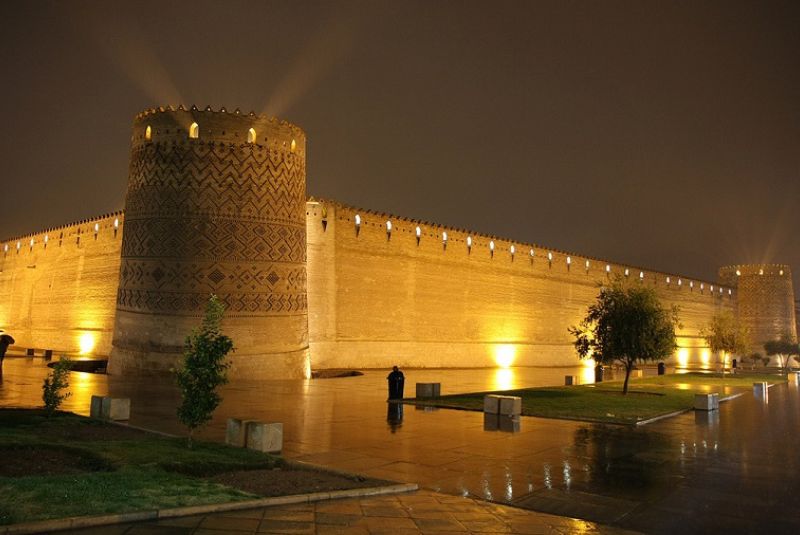
The Arg of Karim Khan served as the residence and seat of power for Karim Khan Zand during his reign. Constructed in 1180 A.H. by Karim Khan, who was known as Vakil al-Raiya, this citadel was built shortly after Shiraz was declared the capital of his government. Karim Khan envisioned a grand square akin to Naqsh-e Jahan Square in Isfahan, selecting a vast area in northern Shiraz and naming it Artillery Square.
Remarkably, Arg of Karim Khan in Shiraz survived the widespread destruction of the Mohammad Khan Qajar era. Following his conquest of Shiraz, Mohammad Khan Qajar ordered the demolition of several buildings erected by Karim Khan due to their enmity. This led to the complete destruction of several Zand-era structures, including the city walls. Despite these orders, the citadel itself remained largely intact.
During its time, the citadel served as the imperial palace and housed the emirs of Fars province, who were appointed by the central government. Throughout the Qajar period, the citadel underwent numerous alterations based on the preferences of the ruling emirs, resulting in significant changes and occasional damage.
The Pahlavi period brought further transformations to the citadel, leading to considerable damage. In 1931, with the establishment of the Shahrbani police headquarters in Shiraz, the citadel was repurposed as a prison. To accommodate prisoners, the halls were converted into two-story units, each containing four to six cells. The original Qajar-era paintings were covered with plaster, and walls were darkened with smoke from fires to maintain warmth.
In 1971, the Department of Culture and Arts took control of the citadel to preserve and protect national artifacts. Today, the citadel is managed by the country's cultural heritage organization and functions as a museum showcasing the rich history of Fars province. The Karim Khan Citadel was officially registered as a national monument of Iran on June 14, 1972, under registration number 918, solidifying its status as a significant cultural and historical landmark.
Architecture and Sections of Arg of Karim Khan in Shiraz
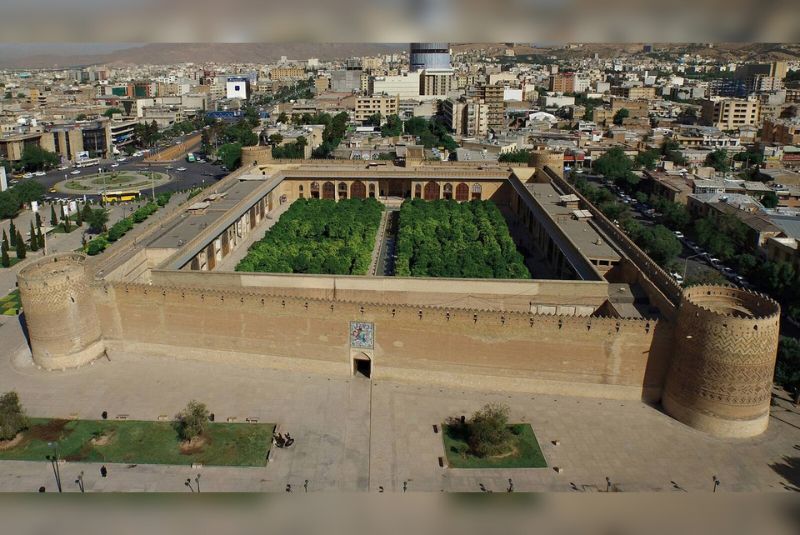
The Arg of Karim Khan spans an area of 12,800 square meters with a built-up area of over 4,000 square meters, featuring distinct residential and military sections. The interior residential area is adorned with beautiful paintings and walls, while the exterior is fortified with 12-meter high walls. Each of the four corners of the citadel is marked by a 14-meter high tower, each with three floors. During the Zand era, these towers were used for guarding, and their floors served as rest areas for soldiers and storage for weapons.
Historically, a moat was dug around the citadel to enhance its security and defensive capabilities. Interestingly, the eastern side of the citadel is tilted, likely due to the presence of a bathhouse and constant moisture, which has affected the structure and materials over time.
The citadel's layout is rectangular, incorporating both military and residential areas. Built during the Zand era by skilled craftsmen using high-quality materials, each section of the citadel served specific purposes. The citadel's defensive walls, standing 12 meters high and 3 meters thick, are simple and undecorated. The four round, three-story towers in each corner housed the armory, observation posts, and resting places for soldiers. A deep moat once surrounded the citadel and its walls, although no traces of it remain today.
Upon entering the citadel, visitors are greeted by a large courtyard filled with orange trees, a pond, and a picturesque waterway. The simplicity of the brick walls creates a beautiful atmosphere, enhanced by the cool and refreshing presence of the water pond.
Entrance

The entrance to Arg of Karim Khan is marked by a door adorned with intricate Qajar-era tiling depicting the battle scene of Rostam and Div-e Sepid (White Demon).
Originally built during the Zand era, these tiles were added later, reflecting the changing tastes over time. Inside, the residential section spans three directions: North, South, and West. Each side features a porch with two columns. Initially stone, these columns were replaced with wooden and spiral columns after the occupation by Mohammad Khan.
Residential Section

The residential area includes two floors and six rooms on either side of the hall, added during the Pahlavi period to accommodate prisoners. The halls are characterized by beautiful sash windows, which are wooden frames with colored glass that open and close vertically, giving the interior an open and spacious feel. The roof features a double-layered design with an upper false ceiling slightly above the lower one, adorned with impressive moqarnas work, paintings, and tiles that are reminiscent of Safavid art.
Shah-neshin
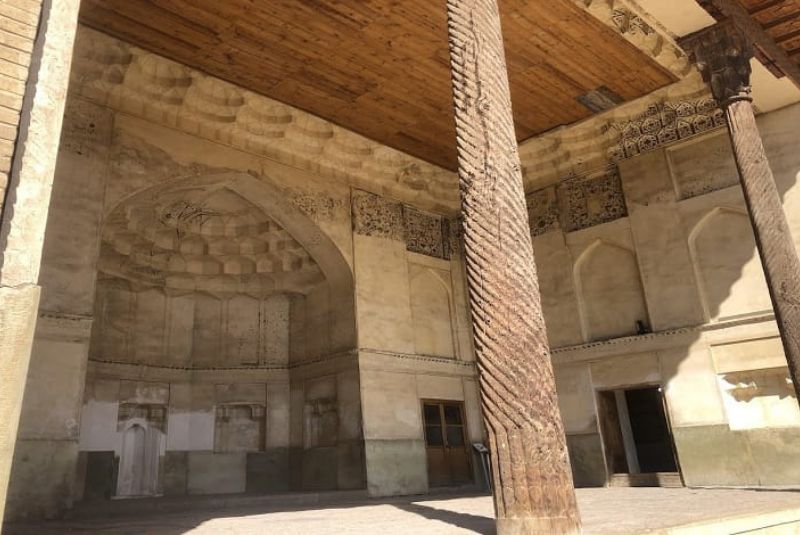
Shahneshins are large rooms with high ceilings, also known as three-door or five-door rooms, located on the northern, western, and southern sides of the citadel. These rooms boast exquisite decorations. The Northern Shahneshin, designed for winter use, features two monolithic stone columns known as Gandomak, adorned with Shah Abbasi floral motifs. The roof of this room is decorated with intricate and artistic moqarnas.
The Western Shahneshin, primarily used during the summer, serves as the main residence. Situated opposite the large pond in the courtyard, this room has wooden columns with spiral decorations made of cedar. The tops of these columns are also adorned with beautiful moqarnas, showcasing the pinnacle of Zand-era architectural art.
The Southern Shahneshin, suitable for use throughout the year, is known as the "four seasons" room. This space also features stunning decorations, maintaining the aesthetic consistency found throughout the citadel.
Among the notable decorations of the Shahneshins and other parts of the citadel are the sash windows with colored glass, moqarnas, plinths, and intricately designed walls and niches. The decorations often take inspiration from Safavid-era paintings, with architects and master craftsmen of the Zand period using materials such as gold, mercury, and ocher to create various motifs.
Backyard

In the northern direction of the citadel lies a backyard with several separate rooms. The courtyard, located next to the towers, features a central pond. Historically, these courtyards served as kitchens or areas for serving the tower residents.
Karim Khan Zand Bath
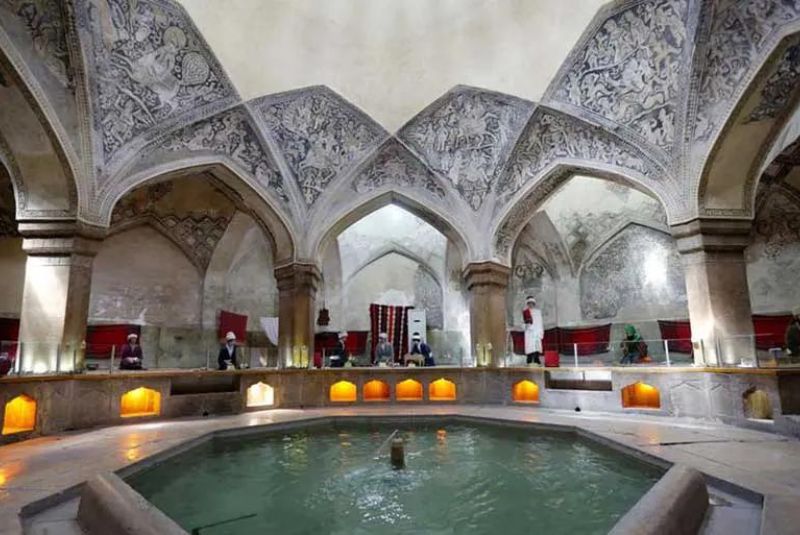
The southern part of the citadel houses a bath dating back to the Zand era, which remains open to visitors. Notable for its design, the bath features four single-piece stone pillars inside the greenhouse, adorned with intricate decorations. The floor of the bath is kept warm through an innovative heating system, adding to the bath's distinctive appeal.
Attractions Around Arg of Karim Khan
After visiting Arg of Karim Khan in Shiraz, there are several nearby historical attractions in Shiraz worth exploring. These sites provide a deeper insight into the rich cultural and architectural heritage of the city. Here are some notable places to visit:
Vakil Historical Bath
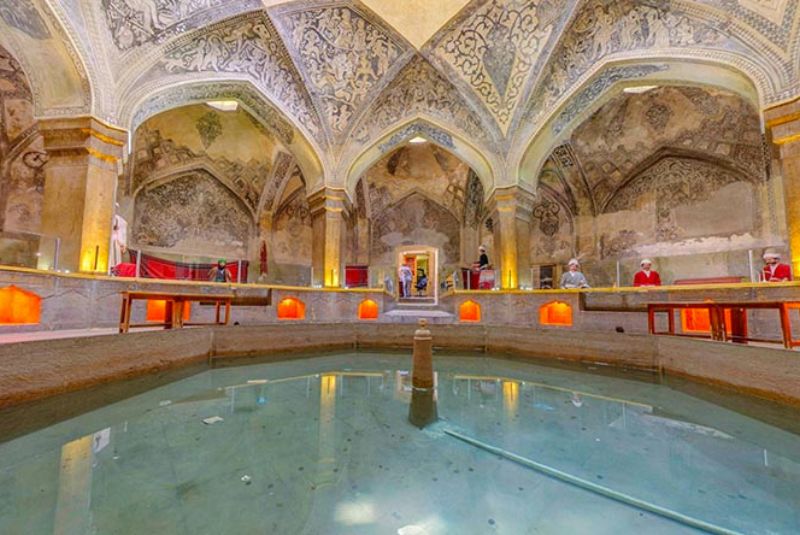
Hammam Vakil, a must-see attraction in Shiraz, dates back to the Zandiyeh period and is listed among Iran's national heritage sites. Known for its exquisite limestone carvings and paintings, this bathhouse has been transformed into an anthropological museum. Visitors can learn about the customs, clothing, and culture of ancient Shiraz through its displays. Historically, Hammam Wakil was more than just a place for bathing; it hosted various events and ceremonies. Today, visitors can enjoy traditional sculptures and local music, providing a vivid depiction of its historical significance.
Vakil Bazaar
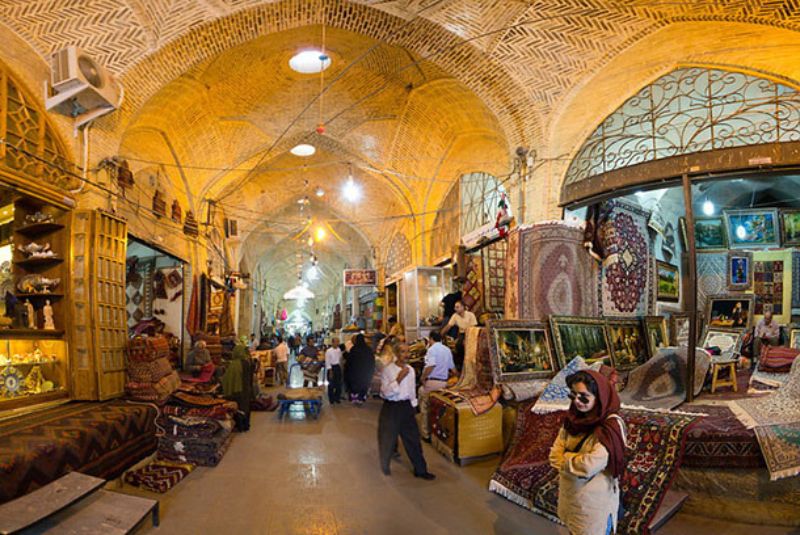
Located in the heart of Shiraz near the Isfahan Gate, Vakil Bazaar is one of Iran's oldest and most renowned markets. Its strategic location facilitated significant trade between Isfahan and Shiraz, attracting merchants from both cities. The market remains bustling with commerce, attracting tourists who appreciate its historical texture and beautiful architecture. The area is also home to numerous restaurants, cafes, and taverns where visitors can relax and enjoy local cuisine.
Vakil Mosque
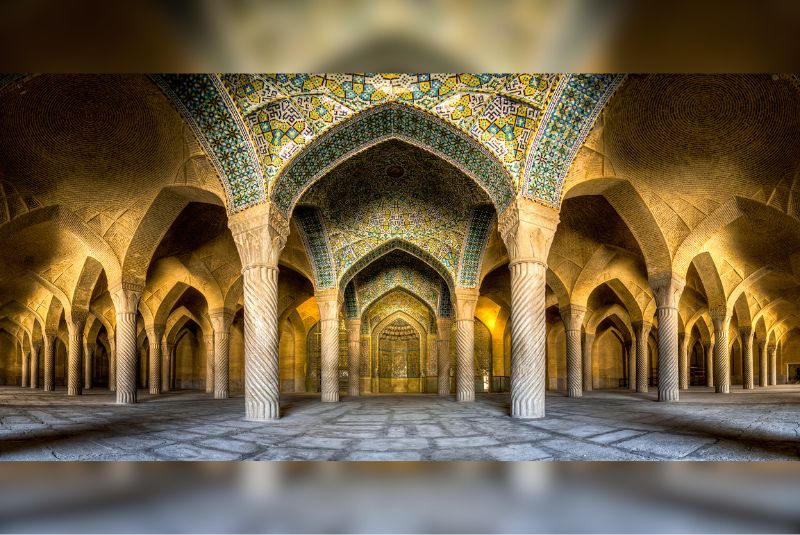
Vakil Mosque, also known as Sultani Mosque, is another stunning part of the Vakil complex built during the Zandiyeh period by the order of Karim Khan Zand. The mosque's architecture includes two porches and two naves in the southern and eastern parts. Key features include the entrance, corridor, courtyard, large nave, winter nave, mihrab, Islamic marble pulpit, and the remarkable pearl arch. The intricate carvings and arches, especially the three unique arches in Shiraz—the entrance arch, the pearl arch, and the large Shabestan arch—are particularly noteworthy.
Pars Museum
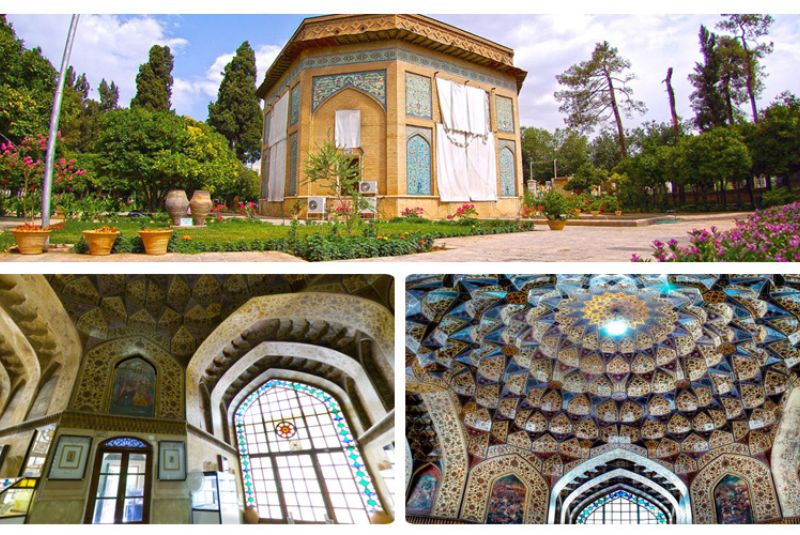
Pars Museum, one of the prominent attractions in Fars province, showcases works by famous painters from the Zandiyeh period as well as contemporary artists. The museum, located in Shiraz, also features plinth stones from Khurshid Palace with Shahnameh motifs in its outer area. As the oldest museum in Fars province, it houses valuable artifacts, including metal objects, pottery, coins, and seals dating from the fourth millennium BC to the contemporary era.
Zinat Al-Molk Historical House

Zinat al-Muluk House, an architectural marvel from the Qajar period, took about 12 years to build. The house features wooden ceilings adorned with images of animals, birds, flowers, and plants. Located one street away from Qavam Bagh, it is connected to Qavam Bagh by an underground passage, serving as its secret and interior section. Inside the house, visitors can find wax statues of famous personalities and historical figures of Shiraz, adding to its historical charm.
These attractions around Karimkhan Citadel offer a comprehensive glimpse into Shiraz's historical and cultural landscape, making them essential stops for any visitor to the city.
Karimkhan Citadel Location and Access

Arg of Karim Khan is centrally located in Shiraz on one of the city's main thoroughfares, Karim Khan Street. This prime location makes it easily accessible by various means of transportation.
Getting There
- By Bus or Taxi: You can conveniently reach the citadel using Shiraz’s bus network or by hiring a taxi. However, it's important to note that the citadel does not have its own parking facilities. Visitors traveling by private car will need to find parking on the surrounding streets.
- By Metro: If you prefer to use the metro, disembark at the nearest station, Zandiyeh. From there, it is a 10-minute walk to Shiraz Martyrs Square. Alternatively, you can shorten this walk by taking a taxi for the remainder of the journey.
- From Tehran: For visitors traveling from Tehran to Shiraz, flights are available. Once in Shiraz, you can use local transportation to visit the citadel and other attractions in the city.
Address
Location: Shiraz, Karim Khan Zand Street, Shohada Square, the beginning of Hijrat Street.
Visiting Hours
The citadel is open to the public, and the visiting hours are as follows:
- First Half of the Year: 8:30 AM to 9:00 PM
- Second Half of the Year: 7:30 AM to 8:30 PM
It is recommended to allocate about an hour for your visit to fully appreciate the magnificence of Arg of Karim Khan in Shiraz. Please note that there is a small entrance fee for visiting this historical site.

Final Takeaway
When traveling through Iran, be sure to visit the Arg of Karim Khan in Shiraz. This citadel offers insight into the historical legacy and architectural style of the Zand dynasty. Explore its unique beauty and historical significance, and discover the stories behind this iconic landmark.
Share your story!
Comment below and let us know about your Experience.
Your story inspires others!


Comment
Leave a Comment